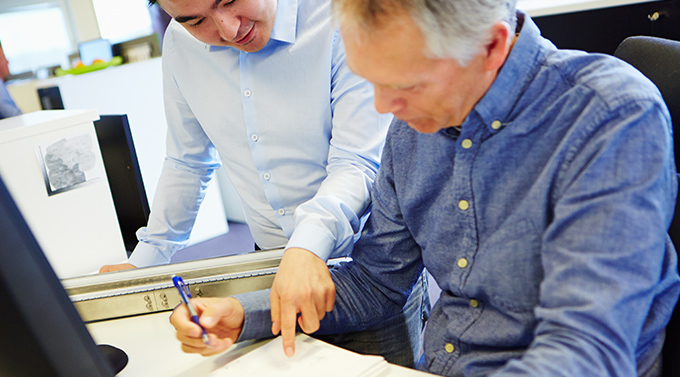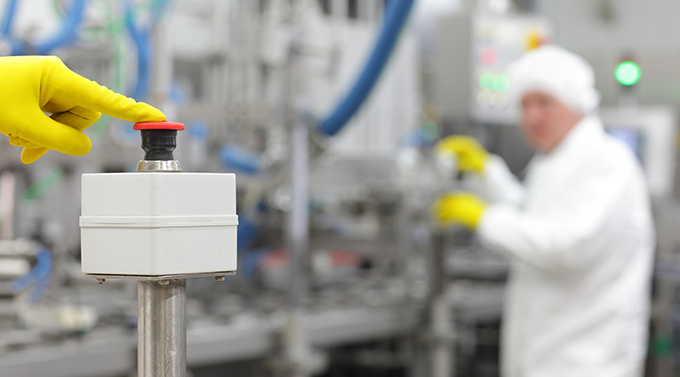
No matter which manufacturing industry you operate in, machine safety is top priority. For a machine manufacturer to produce a CE-marked user-friendly machine, the development process needs to follow the European Machinery Directive. CE-marked machines mean trust and reliability for the equipment, which will benefit both the production and the operators.
Machinery Directive – a regulatory framework the machine manufacturer needs to follow
To ensure safe use of production machines, EU has implemented a Machinery Directive. The Machinery Directive 2006/42 EC is a European regulatory framework, describing the rules that the machine manufacturer needs to follow. The Machinery Directive contains rules and technical demands that the machine needs to live up to, and the directive has been translated into law in all EEA countries (European Economic Area). This Machinery Directive is specifically for Europe, but there are similar regulations all across the world. Harmonized standards provide voluntary guidance in how to follow the rules of the directive. When your machine lives up to all the requirements in the Machinery Directive, it can be put into service or released on market.
New European harmonized standards are constantly being created and they often work as reference points when other non-European countries are establishing their national standards.
Self-certification puts high demands on the machine manufacturer
 The process of going through a Machinery Directive and getting a machine CE-marked varies depending on how complicated the machine is, and how experienced the evaluating team is. The European system is based on self-certification, putting high demands on the machine manufacturer. That means the manufacturer is responsible for conducting a risk assessment, which will continue during the entire development process of the machine. This is a quality process, where the manufacturer needs to know which requirements there are to comply with. A risk assessment includes identifying all the hazards, estimating the hazards and identifying how dangerous they are. Then, the manufacturer eliminates or reduces all the risks until the machine is safe.
The process of going through a Machinery Directive and getting a machine CE-marked varies depending on how complicated the machine is, and how experienced the evaluating team is. The European system is based on self-certification, putting high demands on the machine manufacturer. That means the manufacturer is responsible for conducting a risk assessment, which will continue during the entire development process of the machine. This is a quality process, where the manufacturer needs to know which requirements there are to comply with. A risk assessment includes identifying all the hazards, estimating the hazards and identifying how dangerous they are. Then, the manufacturer eliminates or reduces all the risks until the machine is safe.
Major changes to the directive in 2009
In 2009, the Machinery Directive was updated and introduced new rules. One of the new rules was the introduction of the partly completed machine, as a compliment to the completed machine. The requirements differ between completed machines and partly completed machines. A partly completed machine is missing something and is therefore not ready to be used. It is designed to be built in, as a part of a whole, and therefore can’t operate on its own. Partly completed machines must never be CE-marked, because only completed machines are allowed to be CE-marked.
Another rule that was introduced in 2009 was the full quality assurance. That means you should describe, in an internal technical documentation, how you ensure that your machine has been manufactured according to the Machinery Directive.
CE marking – a guarantee for safe use of a machine
After the machine manufacturer has gone through the Machinery Directive with all necessary risk assessments and eliminated them, the machine manufacturer is responsible for CE marking the machine. According to the law, all completed machines operating in the EEA countries have to have an individual CE marking. A CE marking is a guarantee for safe use, and the completed machine must not be used without the marking. Both individual machines, including conveyors, and complete production lines can be CE-marked. In some cases, several individual machines are merged together, which is an initiative that usually comes from the end-customer. The merged machines are considered as one large machine or as one unit. The person initiating the merge will be responsible for the new CE marking, which will be one common marking for the whole system. Since a machine can have only one CE marking, the individual marks will be removed and replaced with one common marking for the whole machine. This is to avoid ambiguity and promote transparency and traceability.
Risk assessment and certificates prove who is responsible for the machine
 The marking shows who manufactured the machine and who is responsible for it. In addition to the marking, the machine should come with certain documents. It should have a user instruction, a manual and a declaration stating that you have fulfilled the Machinery Directive. Aside from that, the authorities also require that the machine should have a confidential technical documentation. The technical documentation includes the risk assessment, which is central to the whole process.
The marking shows who manufactured the machine and who is responsible for it. In addition to the marking, the machine should come with certain documents. It should have a user instruction, a manual and a declaration stating that you have fulfilled the Machinery Directive. Aside from that, the authorities also require that the machine should have a confidential technical documentation. The technical documentation includes the risk assessment, which is central to the whole process.
All partly completed machines need a marking. However, partly completed machines are the only machines that don’t need a CE symbol, since they can’t be used on their own. Many make the mistake of thinking there is something wrong with machines without a CE symbol, but when it comes to partly completed machines that is not the case. After delivering a machine to a production plant with all related documents, it is the customer’s responsibility to make sure the operators are trained in how to use the machine, to guarantee the operators’ safety. The manual brings up possible remaining risks such as loud noise, which the employer should take into account, and for example, provide the operators with hearing protection. The manual also brings up how the machine should be installed and maintained.
FlexLink delivers safe and CE-marked completed machines
For FlexLink, safety is of the essence, no matter what manufacturing industry you are operating in. A CE-marked machine protects the operators from all types of injuries, from high noise levels to risk of crunching, to more serious accidents such as a machine tipping over you during installation. A CE-marked machine means trust and reliability for the equipment, making sure operators can work comfortably with and around the machine.
I hope you enjoyed reading my article, and that you gained some new knowledge about CE marking and machine safety. Share your thoughts on our social media channels and pop by our website for more information. For more specific questions, contact me directly.




Leave a Reply